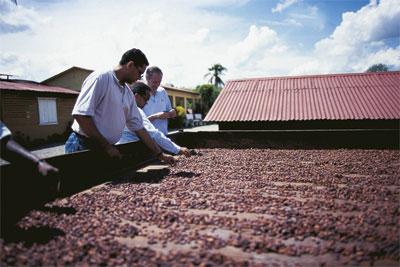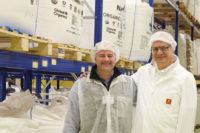
|
Angelo Agostoni can remember when cocoa beans harvested from West Africa looked like they were “painted by hand.” They were “perfect,” he says. Of course, that was nearly 45 years ago. Since then, the quality of the beans has deteriorated tremendously.
Fortunately, the president of Lecco, Italy-based ICAM focused his search for fine-flavored cocoa beans in Central and South America. So it was quite serendipitous when he recently received an invite from a friend in Uganda to come and visit.
And while Uganda has quite a reputation for growing coffee beans, its experience with cocoa beans has been meager at best. Output was relatively small and the quality was poor.
“The cocoa beans were poorly fermented, almost to the lowest acceptable levels,” he explains.
During his visit, Agostoni, aside from meeting with government and business representatives, saw an opportunity to spend some time with cocoa farmers. He quickly discovered that Uganda, unlike other African cocoa-growing countries, had quite a different agricultural environment than most cocoa-growing regions.
First, the farmers worked on very small plots of land, from one to two acres. Second, there was no history of cooperatives in Uganda. And third, the cocoa crop was grown in a mountainous region, 1,000 meters above sea level. Finally, there was no infrastructure.
During his conversations with the farmers, Agostoni discovered that they were frustrated in putting so much effort into their cocoa crops and seeing little return.
“They felt neglected by the cocoa traders and surprised that their efforts were not rewarded in the marketplace,” he says. “Nonetheless, they were impressed that a European manufacturer had taken the time to discuss their concerns with them.”
Well, Agostoni did more than just discuss their concerns; he acted on them.
After having discussions with mutual acquaintances in Uganda, including the Bishop of Kampala, he realized that the solution lay in establishing a centralized fermentation center. The key difference in the approach, however, was that the farmers would bring fresh cacao beans to the center. In return, Agostoni would pay them the same price as if they had fermented the beans themselves.
This innovative solution not only reduced the workload and risk for the farmer — many of them fermented the beans within their homes — it enabled Agostoni to establish a uniform and consistent fermentation process for all beans collected.
“Because of the different growing conditions, standard fermentation parameters didn’t apply,” he says. “We were able to develop proper parameters for fermentation and, in turn, received excellent and consistent quality beans. No one had ever achieved that before.”
The first crop totaled only a few hundred pounds. Today, however, the total has risen to 1,500 tons. More importantly, other parties in Uganda have begun to look at this novel approach and have begun to apply it in other areas of the country.
Recognizing that the central fermentation concept is limited by distance — fresh beans will begin to ferment by themselves within six hours — Agostoni is looking at building another central fermentation center.
“The people are really proud of the center,” he says. “And other farmers are coming to us with fresh beans. I’m really pleased with the results of the project and that we were able to become a catalyst in changing the situation there.”
Even the United Nation’s Food and Agriculture Organization (FAO) has approached Agostoni about the project, citing it as an example of innovative crop management in Africa.
And all it took was an “Angelo” in Uganda to make it happen.





